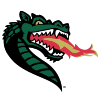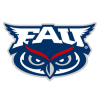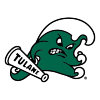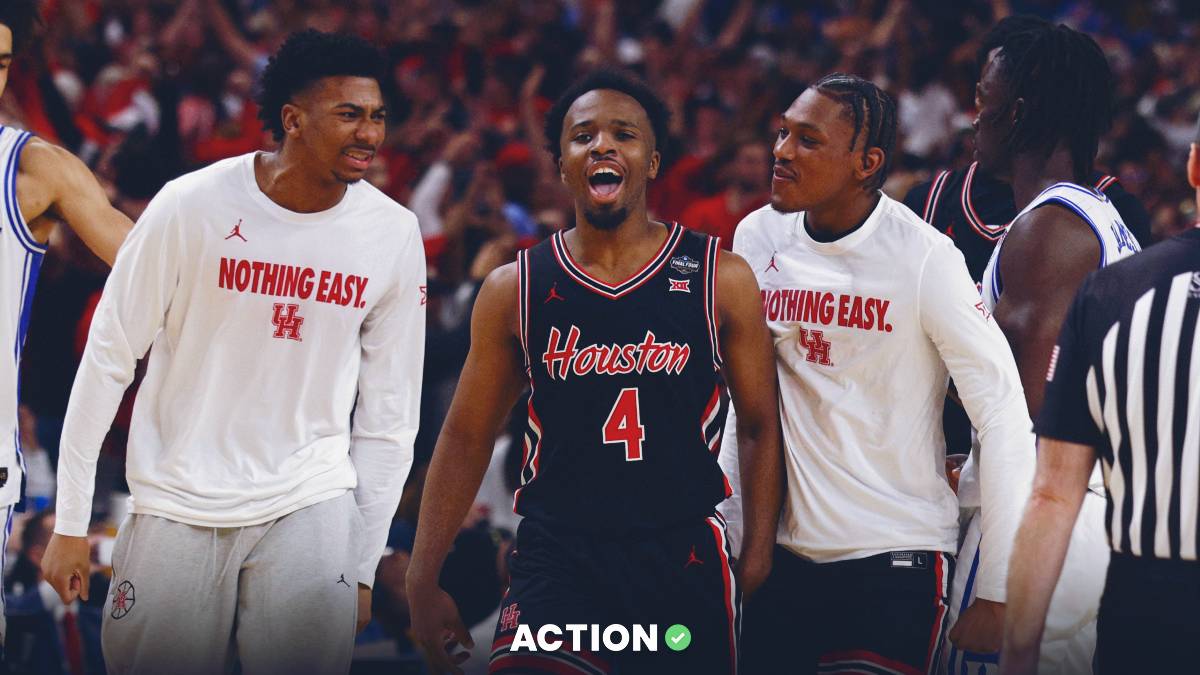The AAC is in a fun spot.
The league was chaotic last season, with South Florida surging to the regular season title despite ranking fifth among conference teams in KenPom’s net rating. FAU and UAB made the American a two-bid league, while an absurdly talented Memphis team underperformed again under Penny Hardaway.
This year, the AAC has the fewest returning minutes of any college basketball conference (31%). There will be a lot of newness and fresh faces, which should produce more chaos, especially with the conference-favorite Tigers again sporting an uber-talented roster led by Hardaway.
From a 30,000-foot level, I see two clear-cut league favorites, nine middling in-the-mix squads and two clear-cut AAC cellar dwellers.
Here's my AAC betting preview for the 2024-25 college basketball season.
2024-25 AAC Regular Season NCAAB Conference Title Odds
| Team Name | Odds (Via BetMGM) |
| Memphis | +125 |
| UAB | +325 |
| North Texas | +500 |
| Wichita State | +900 |
| South Florida | +1200 |
| FAU | +1800 |
| Charlotte | +2000 |
| East Carolina | +3000 |
| Temple | +3000 |
| Tulsa | +6000 |
| Tulane | +8000 |
| Rice | +10000 |
| UTSA | +10000 |
Tier 1: The AAC Favorites
Memphis Tigers
If we're going by pure talent assembled, Memphis is the prohibitive favorite in the American this season.
The transfer class is bonkers. It's the fourth-highest-rated class nationally by Bart Torvik and the 11th-highest-rated class by 247Sports.
Penny Hardaway’s defense is built upon pressure, and the Tigers' offense is built around turning turnovers into quick-strike at-the-rim transition buckets. The Tigers attack relentlessly on both ends of the court and will rank near the nation’s top in tempo again.
Transfers Tyrese Hunter (Texas) and PJ Haggerty (Tulsa) are perfect fits.
Haggerty is a high-usage, ball-screen-centric guard who’s uber-efficient in transition. Hunter is an elite press defender who forces between one and two steals a game and turns them into transition buckets.
The frontline additions of 7-foot rim protector Moussa Cisse (Ole Miss) and crafty mid-post scorer Dain Dainja (Illinois) are highly intriguing.
All that said, do we really trust Hardaway? This program has been a bit of a circus since he’s taken the reigns, and the Tigers rarely overachieve.
The collective problem seems to be properly reading and reacting in a free-flowing offensive system – turnovers have plagued them for years.
Newcomers Haggerty and Hunter averaged a combined 5.3 turnovers per game last year. Haggerty’s high usage meant his turnover rate remained relatively low (12%), while Hunter’s was exceedingly high given his lower-usage offensive role (21%).
Either way, the new backcourt won't solve the prior one's issues.
There’s also zero shooting outside swingman Colby Rogers (Wichita State transfer), and the offensive limitations in the frontcourt could create spacing nightmares.
Given Memphis’ high volatility, it’s probably wise to fade it by targeting other teams in the American futures market.
I’m fascinated to see how Memphis handles an absurd non-conference schedule, with eight games against KenPom top-100 teams, including showdowns with UConn and Clemson.
I’m partial to believing a team with such high roster turnover will struggle early on, but Penny rebuilt his roster last year and ran wild through Christmas, posting four non-con wins over KenPom top-75 teams (VCU, Texas A&M, Clemson, Virginia).

UAB Blazers
The Blazers will be fun.
There’s no more Jelly Walker or Eric Gaines, but Andy Kennedy will scheme offense around Georgia Southern transfer Tyren Moore. The pro-style point guard dropped 17/3 last year on insane 47%/40%/87% shooting splits while limiting turnovers.
He was among the highest-usage, highest-efficiency guards in the mid-major ranks, and he’ll be a stud at UAB.
Pairing him with the insanely talented Yaxel Lendeborg gives UAB the conference’s best inside-out duo. The 6-foot-9 quasi-center is a true do-it-all forward. He’ll drive downhill and make plays from the wing.
Down low, he’ll post-up (1.08 PPP, 89th percentile) on offense and clean the boards (7.5 defensive rebounds per game) on defense.
Perhaps most importantly, he’s among the nation’s most dominant offensive rebounders. He and Christian Coleman will ensure UAB remains a top-20 offensive rebounding and second-chance scoring squad.
I like the wing depth. There’s plenty of shooting between Alejandro Vasquez and Efrem “Butta” Johnson, plus Iona transfer Greg Gordon can get to the rim.
The defense leaves plenty to be desired, but Kennedy will play conservatively, running a shell defense that keeps guys away from the rim. Also, don’t sleep on Coleman as a shot blocker.
Meanwhile, UAB will out-score everyone. Don’t be surprised if Lendeborg wins American Player of the Year, Moore wins Newcomer of the Year and the Blazers win the regular season conference title.
Tier 2: In The AAC Mix
North Texas Mean Green
Ross Hodge can coach. He’s built a strong shell defense that excels at taking away the interior.
While the Mean Green were ripped apart in the portal (27% of minutes return), the six-player transfer class features six plus defenders by EvanMiya’s DBPR. Plus, returning starters Rondel Walker and Moulaye Sissoko might be the two best defenders on the team.
The offense could be a mixed bag. It’ll likely come down to the backcourt transfer trio of Jasper Floyd, Atin Wright and Latrell Jossell. Hodge’s down-pace ball-screen spread offense is predicated on strong ball-handling and shooting.
Wright was a strong playmaker at Drake who shot 40% from deep. Jossell is a versatile two-way player who shot 37% from deep at Stephen F. Austin. Floyd should run the offense after averaging over four assists per game at Fairfield, although he was limited as a ball-screen creator (.69 PPP, 34th percentile) and is far from an efficient scorer (38% from the field, 33% from 3).
Keep an eye on Johnathan Massie. The Longwood transfer is a highly versatile four who could be the Mean Green's X-factor.
The floor is super high for North Texas, and it could be in for some positive close-game regression after going 4-11 in games decided by six or fewer points last year.
Wichita State Shockers
It was a brutal Year 0 for Paul Mills. But with four starters and nearly 60% of minutes returning – making the Shockers the most experienced roster in the AAC – 2025 should go much smoother.
The Shockers also hit the portal hard, bringing in Justin Hill (Georgia) as the new point guard and three critical bench wing/forward shooters in Corey Washington (Saint Peter’s), AJ McGinnis (Lipscomb) and Zane Meeks (Arizona State).
As you may remember from his Oral Roberts days, Mills runs a spread ball-screen offense that will leverage guards in creation and big men as pick-and-pop shooters.
Hill is an outstanding pick-and-roll initiator and facilitator, Meeks is a great stretch four and McGinnis is a lights-out shooter on the wings. Washington is more of a glue-guy contributor.
The returning quartet of Xavier Bell, Harlond Beverly, Ronnie DeGray III and Quincy Ballard will play monster roles.
DeGray is another solid stretch big, while Ballard is a monster interior defender and rebounder. Bell and Beverley are do-it-all guard pieces that combined to average 22 points, eight rebounds, five assists and three steals last year. Also, Beverley is a plus perimeter defender.
Depth is a strength. But general shooting is a problem – both off-the-bounce and in spot-up situations. Bell, Beverly and Washington all shot under 30% from deep last year. Hill and DeGray weren’t much better at 32%, and Ballard doesn’t stretch the floor.
A lack of shooting in a spread pick-and-roll offense might hold this group back.
South Florida Bulls
We at the Action Network are devastated to learn about Amir Abdur-Rahim's passing. We offer our condolences to his family and players during this difficult time.
Associate head coach Ben Fletcher will be the interim head coach for the 2024-25 season.
The Bulls were pillaged in the portal, losing three double-digit scorers. But there’s a mix of returning role players and transfers who all could break out in more prominent roles.
Sophomore point guard Jayden Reid is a sleeper candidate for All-Conference. He recorded over three assists per game last year in less than 23 minutes a game. He dished out 101 assists to only 49 turnovers and added over a steal per game while shooting 48% from 3.
He’ll dish it out to versatile glue-guy wings Kobe Knox, Brandon Stroud and Quincy Ademokoya. Knox scored at least 15 in three games last year – he might ascend to the No. 1 option on a team with zero high-usage scoring experience. Ademokoya shot 35% from 3 last year at Kennesaw State.
The frontcourt will likely be manned by two transfers: D’Ante Green from Florida State and Jamille Reynolds from Cincinnati. Reynolds averaged four rebounds and shot 43% from 3 in just 14 minutes per game last year.
This squad has sneaky depth; the question is who steps up.
Also, can the Bulls avoid two-way shooting regression? During league play last year, they led the conference in 3-point shooting (38%) and 3-point defense (30%), which simply can’t be sustainable.

Florida Atlantic Owls
New head coach John Jakus begins his role as Owls head coach after a four-year assistant coach stint running Baylor’s uber-dangerous spread ball-screen attack with guards like RayJ Dennis, LJ Cryer, Adam Flagler and – of course – the Jared Butler-Davion Mitchell-MaCio Teague trio that won a National Championship.
In theory, he has the backcourt to run a similar scheme at FAU. KyKy Tandy, Leland Walker and Ken Evans Jr. all transfer in as lights-out spot-up shooters and capable ball handlers.
Walker is the best distributor and downhill driver of the three – although Tandy is no pick-and-roll slouch – while Tandy and Evans cashed in nearly 40% of their triples last season. The pieces are all there.
That said, it’s not easy to replicate college basketball’s most dangerous guard-heavy offensive scheme, and Jakus will attempt that feat at a new school with an entirely fresh roster. His rotation will essentially be six transfers and two international prospects.
Defense and depth are the big issues.
7-foot Florida State transfer Baba Miller and 6-foot-7 redshirt junior Tre Carroll are intriguing offensive pieces in the frontcourt, but neither profile as a solid interior anchor or rim protector. 7-foot Matas Vokietaitis figures to crack the frontcourt rotation, but he’s never played a minute of college ball.
They don’t really have a solid fourth guard piece either unless Louisville transfer Kaleb Glenn hits. He’s a versatile hybrid wing with a high ceiling.
Still, depth remains sketchy at best, and this is the second least experienced team in the conference.

Charlotte 49ers
It’s wild to think how Aaron Fearne almost won the league as the interim head coach last season. The 49ers were 11-2 in league play before a three-game losing streak snapped their championship hopes (Memphis, Tulsa, South Florida).
Unfortunately, like most AAC squads, his roster was gutted in the portal. The Niners lost their top three scorers and four of five starters.
Fearne was unhappy about his team’s lack of rebounding last season (11th in the league in both offensive and defensive rebounding rate), so he recruited more size – even after ranking 26th nationally in average height.
Four incoming big men – Jeremiah Oden, Giancarlo Rosado, Nika Metskhvarishvili, Aleksander Szymczyk – join returnees Robert Braswell, Dein Reiber and Rich Rolf to give Fearne seven players that stand between 6-foot-7 and 6-foot-10.
This could be a good thing, considering that Fearne likes to play through the post on offense. Oden is a smooth inside-out slashing wing who can play the 4, while Rosado and Metskhvarishvili are excellent passers out of the post and can be hubs for the offense.
Who will they pass to? Likely returning guards Nik Graves and Isaiah Folkes, alongside Coastal Carolina transfer Kylan Blackmon.
Graves is a good facilitator but less of a shot-maker – although he knows how to get to the line. Folkes is an excellent defender who must find some extra pop on offense. Blackmon is the rim-and-3 threat who should provide extra pop to the offense.
I would also keep an eye on JUCO transfer Jaehshon Thomas, who was a hooper at Florida Southwestern State.
While Fearne can scheme interior offense and perimeter defense – expect a heavy dose of full-court man-to-man pressure – I have two reservations.
First, there's not much proven Division-I shooting on the roster for a squad that finished 10th in the AAC in 3-point shooting last season (33%).
Second, despite all the size, there’s no true rim protector, so the interior defense may again be vulnerable.
East Carolina Pirates
The Pirates got shredded by the portal, losing four starters. But I don’t mind this year’s roster.
I love RJ Felton. He’s an absolute superstar – a true high-usage, high-efficiency combo guard who will be electric playing off-ball with the dynamic Cam Hayes doing most of the ball-handling work.
Felton can score from anywhere on the court and might average 20 points per game this season.
Keep an eye on Yann Farell from St. Bonaventure (a 3-and-D swingman), Julien Soumaoro from Gardner-Webb (a 5-foot-10 point guard with a decent offensive bag) and Jordan Riley (a fantastic, versatile wing defender).
The X-factors on the team are likely C.J. Walker and Cyr Malonga.
Head coach Mike Schwartz – who enters Year 3 with the Pirates – was the architect of Tennessee’s elite defense before taking the job at East Carolina. It’s a pressure-happy scheme that leverages speedy guards to run around and force turnovers.
However, that leaves the interior vulnerable. The Pirates were shredded down low last season, ranking last in the conference in 2-point defense (52%) and 12th in defensive rebounding rate.
Walker is a 6-foot-8 undersized four, but he’s super athletic and vertically bouncy. If he could channel some of that athleticism into rim protection and shot blocking, he could be a lovely last line of defense.
While Molonga played two minutes per game last season, he’s a positively monstrous 6-foot-11 presence with a half-decent 4.4% block rate. Any rim protection would help in Greenville.
For what it’s worth, East Carolina finished fourth in the ACC in defensive efficiency last season despite its abysmal interior presence. A few more blocked or deterred shots and the Pirates are soaring.
On the offensive side of the ball, the 2024 Pirates were among the worst three-level scoring teams in the nation. They finished second-to-last in the American in 2-point shooting (47%) and last in 3-point shooting (31%), so they finished last in the conference in offensive efficiency during league play.
However, I think there’s some unluckiness baked in there. ShotQuality – which projects shot efficiency based on the “quality” of shots taken or allowed, rather than whether the ball went in – projected that last year’s East Carolina team should’ve shot about 3% better at the rim, 2% better from deep and generated about .04 more points per offensive possession.
Almost half of the Pirates' catch-and-shoot jumpers were unguarded (48%), but they shot only 35% on those opportunities, resulting in 1.06 PPS that ranked in the 30th percentile among D-I teams.
Felton is a lights-out shooter and scorer. Farell and Soumaoro can hit between 34% and 35% of their triples. Hayes can penetrate and kick. The 2025 Pirates should be in line for some positive shooting regression.

Temple Owls
Temple’s late-season surge was wildly impressive. After starting 1-11 in AAC play, the Owls won eight of the following 10 en route to a conference tournament championship game appearance – although they eventually lost by 16 to UAB.
It’s hard to say whether that late-season surge was luck-based or if head coach Adam Fisher deserves some love for finding continuity with his roster in Year 1. The Owls shot 38% from 3 across those 10 games, while their opponents shot 30%.
Fisher recruited an uber-fun backcourt in Lynn Greer III and Jamal Mashburn Jr., two guys who combined to score 25 points per game last season. But both guards are shaky defenders and struggle to space the floor, preferring off-the-bounce rim-running or mid-range scoring.
Wings Shane Dezonie, Jameel Brown and Matteo Picarelli can all space the floor, and 6-foot-10 four-man Steve Settle III is a wild two-way unicorn who could earn an All-Conference defensive nod.
I’m unsure if this unit has enough interior defense and rim protection besides Settle, which means Fordham transfer Elijah Gray needs to step up in that area.
Ultimately, it’s fine to believe in the Owls if you believe in Greer and Mashburn. If you don’t, take your business elsewhere.
Tulsa Golden Hurricane
While it will be tough to see Haggerty playing for another AAC squad, there’s still a surprising amount of talent on this Tulsa squad that returns 54% of last year’s minutes.
It starts with stud guard Keaston Willis, who spent last season injured but is a career 14-point-per-game guy who’s averaged 37% from deep. He should help fix an offense that became too rim-reliant last year.
Combine him with Georgia State transfer Dwon Odom – who averaged 12/5/5 last year – and you have a solid two-way backcourt. Both guys can set the table, score and act as legit point-of-the-attack defenders.
The two will run head coach Eric Konkol’s breakneck scheme, which turned nearly eight steals into 15 fast-break points per game last year. The team started ripping downhill as the season progressed, scoring more and more in the open court and at the charity stripe.
Depth is critical in a positionless, modern, up-tempo offense. Konkol added two key versatile, lengthy wing pieces from the portal in Minnesota’s Braeden Carrington and James Madison’s Justin Amadi, who will run alongside Isaiah Barnes and Jared Garcia.
That said, I’m curious if Coach Konkol surrounded the two with enough floor spacers and shooters. Tulsa’s downhill rim-running offense only works when partnered with enough spacing, something that didn’t happen enough last season.
Rising sophomore Tyshawn Archie (37% from 3 last year) and junior Jesaiah McWright (34% from 3 last year) will be crucial there.
There’s also a lack of top-end size, partially by design, but it could hurt a squad that finished 12th among AAC teams in 2-point defense during league play (52%).

Tulane Green Wave
Head coach Ron Hunter is generally an overachiever. He’ll need to exert some magic after losing his top six scorers from last season to graduation or the portal.
The best player on the squad is likely Rowan Brumbaugh, a redshirt sophomore transfer from Georgetown who combines decent size (6-foot-4) with solid playmaking (25% assist rate) and shooting (37% from 3) skills.
He’ll need to spearhead an offense predicated on leveraging individual advantages out of several different actions.
I’d also keep tabs on Siena transfer Michael Eley and Indiana transfer Kaleb Banks. Neither can shoot with range, but Eley is a gifted mid-range scorer, and Banks is a rock-solid wing defender who should thrive in Hunter’s zone scheme.
The zone defense should keep the Wave from falling into the AAC’s cellar. However, more talented teams quickly work through the scheme, and Tulane is much closer to a teardown than a contender.
Tier 3: The AAC's Cellar Dwellers
Rice Owls
First-year head coach Rob Lanier is a good coach. He was unfairly removed from the SMU job.
He brought a trio of former Mustangs to Rice – Jalen Smith, Denver Anglin and Emory Lanier.
Anglin didn’t play last year and redshirted at Georgetown the year before, while Lanier is the coach’s son, so neither is a proven playmaker.
Smith is intriguing, given he’s a solid two-way, low-usage combo guard who can shoot 38% from deep.
I love 6-foot-7 swingman Kellen Amos, who averaged 11/5/2 with Central Connecticut State last year. 6-foot-4 guard Trae Broadnax tossed in 14/4/4 on 47%/34% splits for USC Upstate last season.
Lanier also convinced Alem Huseinovic to return to SMU – the only returning player from last year’s rotation. He shot 40% from 3, which is noteworthy.
Unfortunately, depth is a question mark, and that’s vital to Lanier’s full-court, pressure-happy, swarming defense that creates offense from turnovers.
While Lanier believes he can hit the ground running in Houston, I think there’s too much newness and insufficient proven high-level D-I contributors.
UTSA Roadrunners
After years of helping Nate Oats build his patented Oats-ball system, Austin Claunch will get a shot at the lead chair in San Antonio.
Oats-ball is about exploiting mismatches early and attacking them aggressively. The Roadrunners will play positionless, modern, up-tempo basketball, leveraging the versatility of their playmakers, scorers and shooters.
Unfortunately, Claunch didn’t get much time to build an ideal roster. He’s mish-mashed a hodge-podge of portal divers into some sort of Meep Meep stew. Claunch recruited 12 transfers from 12 different schools, including one player from the JUCO ranks.
The good news is that he's overloaded with guards and wings.
Primo Spears and Marcus “Smurf” Millender can run an offense through the backcourt. Combo guards Paul Lewis and Tai’Reon Joseph can create and attack as depth pieces. Raekwon Horton is a solid all-around playmaker. Skylar Wicks and Damari Monsanto are above-average marksmen.
The bad news is that he recruited zero frontcourt depth and zero rim protectors.
Given that Claunch is an offensive mastermind with an intriguing small-ball mismatch-hunting lineup, you’ll likely see some wildly impressive scoring bursts. We’ll also likely see long draughts of hapless interior defense.
Claunch mostly grabbed as many wings and guards as possible without considering fit. It likely won’t lead to much success this year, but that’s fine for Year 0.
AAC Predictions & Picks
If I'm targeting one of the league's favorites, UAB (+400, DraftKings) is the no-brainer pick.
The Blazers likely have the league's best offense, and there's a reasonably high chance Memphis self-sabotages.
But, given I'm a sicko for longer-shot futures wagers, I'm not against taking a shot with East Carolina (+3000, BetMGM).
I like the Pirates' roster construction. They have an All-Conference top-scoring option (Felton), a decent table-setter (Hayes) and some decent 3-and-D wing depth (Farell, Riley, Soumaoro).
I didn't even mention RJ's little brother, Ladontae, a highly-touted local freshman who could raise the backcourt depth's ceiling.
And they're all due for a bunch of positive shooting regression.
The Pirates could evolve into the league's best defense if the front-line duo (Walker, Molanga) can leverage their size and athleticism into half-decent rim protection in Coach Schwartz's defensive scheme.
Additionally, keep a tab on Tulsa's odds. The Golden Hurricane are listed at 60-to-1 at Caesars but closer to 30-to-1 across the rest of the market.
They have severe issues in the floor spacing and interior defense departments but they're not 60-to-1 bad. They have the third-most returning production in the conference and a great new backcourt led by Odom and Willis.




















